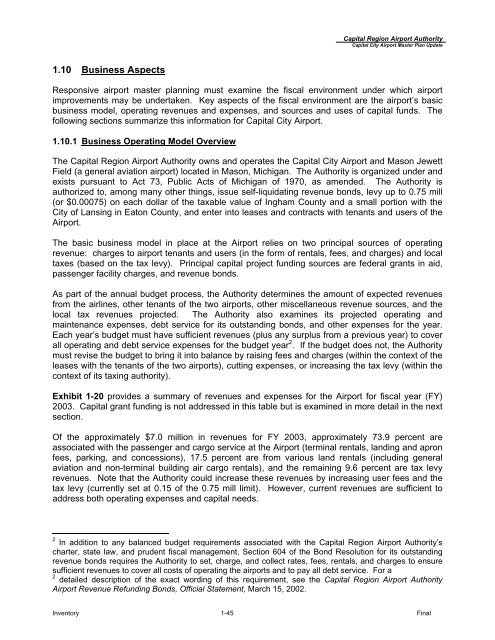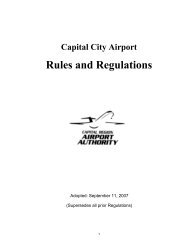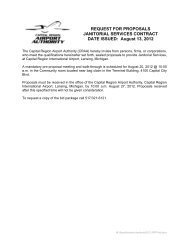Master Plan Update (pdf) - Lansing/Capital City Airport
Master Plan Update (pdf) - Lansing/Capital City Airport
Master Plan Update (pdf) - Lansing/Capital City Airport
You also want an ePaper? Increase the reach of your titles
YUMPU automatically turns print PDFs into web optimized ePapers that Google loves.
1.10 Business Aspects<br />
<strong>Capital</strong> Region <strong>Airport</strong> Authority<br />
<strong>Capital</strong> <strong>City</strong> <strong>Airport</strong> <strong>Master</strong> <strong>Plan</strong> <strong>Update</strong><br />
Responsive airport master planning must examine the fiscal environment under which airport<br />
improvements may be undertaken. Key aspects of the fiscal environment are the airport’s basic<br />
business model, operating revenues and expenses, and sources and uses of capital funds. The<br />
following sections summarize this information for <strong>Capital</strong> <strong>City</strong> <strong>Airport</strong>.<br />
1.10.1 Business Operating Model Overview<br />
The <strong>Capital</strong> Region <strong>Airport</strong> Authority owns and operates the <strong>Capital</strong> <strong>City</strong> <strong>Airport</strong> and Mason Jewett<br />
Field (a general aviation airport) located in Mason, Michigan. The Authority is organized under and<br />
exists pursuant to Act 73, Public Acts of Michigan of 1970, as amended. The Authority is<br />
authorized to, among many other things, issue self-liquidating revenue bonds, levy up to 0.75 mill<br />
(or $0.00075) on each dollar of the taxable value of Ingham County and a small portion with the<br />
<strong>City</strong> of <strong>Lansing</strong> in Eaton County, and enter into leases and contracts with tenants and users of the<br />
<strong>Airport</strong>.<br />
The basic business model in place at the <strong>Airport</strong> relies on two principal sources of operating<br />
revenue: charges to airport tenants and users (in the form of rentals, fees, and charges) and local<br />
taxes (based on the tax levy). Principal capital project funding sources are federal grants in aid,<br />
passenger facility charges, and revenue bonds.<br />
As part of the annual budget process, the Authority determines the amount of expected revenues<br />
from the airlines, other tenants of the two airports, other miscellaneous revenue sources, and the<br />
local tax revenues projected. The Authority also examines its projected operating and<br />
maintenance expenses, debt service for its outstanding bonds, and other expenses for the year.<br />
Each year’s budget must have sufficient revenues (plus any surplus from a previous year) to cover<br />
all operating and debt service expenses for the budget year 2 . If the budget does not, the Authority<br />
must revise the budget to bring it into balance by raising fees and charges (within the context of the<br />
leases with the tenants of the two airports), cutting expenses, or increasing the tax levy (within the<br />
context of its taxing authority).<br />
Exhibit 1-20 provides a summary of revenues and expenses for the <strong>Airport</strong> for fiscal year (FY)<br />
2003. <strong>Capital</strong> grant funding is not addressed in this table but is examined in more detail in the next<br />
section.<br />
Of the approximately $7.0 million in revenues for FY 2003, approximately 73.9 percent are<br />
associated with the passenger and cargo service at the <strong>Airport</strong> (terminal rentals, landing and apron<br />
fees, parking, and concessions), 17.5 percent are from various land rentals (including general<br />
aviation and non-terminal building air cargo rentals), and the remaining 9.6 percent are tax levy<br />
revenues. Note that the Authority could increase these revenues by increasing user fees and the<br />
tax levy (currently set at 0.15 of the 0.75 mill limit). However, current revenues are sufficient to<br />
address both operating expenses and capital needs.<br />
2 In addition to any balanced budget requirements associated with the <strong>Capital</strong> Region <strong>Airport</strong> Authority’s<br />
charter, state law, and prudent fiscal management, Section 604 of the Bond Resolution for its outstanding<br />
revenue bonds requires the Authority to set, charge, and collect rates, fees, rentals, and charges to ensure<br />
sufficient revenues to cover all costs of operating the airports and to pay all debt service. For a<br />
2 detailed description of the exact wording of this requirement, see the <strong>Capital</strong> Region <strong>Airport</strong> Authority<br />
<strong>Airport</strong> Revenue Refunding Bonds, Official Statement, March 15, 2002.<br />
Inventory 1-45 Final




